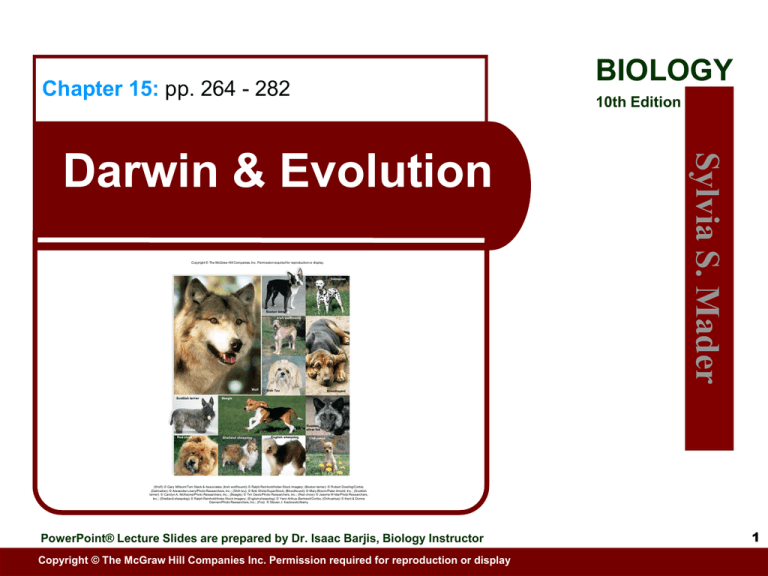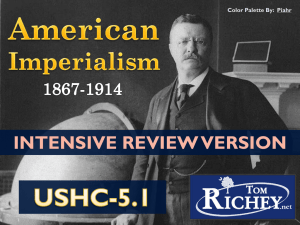Chapter 15
advertisement

BIOLOGY Chapter 15: pp. 264 - 282 10th Edition Copyright © The McGraw-Hill Companies, Inc. Permission required for reproduction or display. Dalmatian Boston terrier Irish wolfhound Wolf Scottish terrier Beagle Red chow Shetland sheepdog Shih Tzu Sylvia S. Mader Darwin & Evolution Bloodhound Russian silver fox English sheepdog Chihuahua (Wolf): © Gary Milburn/Tom Stack & Associates; (Irish wolfhound): © Ralph Reinhold/Index Stock Imagery; (Boston terrier): © Robert Dowling/Corbis; (Dalmation): © Alexander Lowry/Photo Researchers, Inc.; (Shih tzu): © Bob Shirtz/SuperStock; (Bloodhound): © Mary Bloom/Peter Arnold, Inc.; (Scottish terrier): © Carolyn A. McKeone/Photo Researchers, Inc.; (Beagle): © Tim Davis/Photo Researchers, Inc.; (Red chow): © Jeanne W hite/Photo Researchers, Inc.; (Shetland sheepdog): © Ralph Reinhold/Index Stock Imagery; (English sheepdog): © Yann Arthus-Bertrand/Corbis; (Chihuahua): © Kent & Donna Dannen/Photo Researchers, Inc.; (Fox): © Steven J. Kazlowski/Alamy PowerPoint® Lecture Slides are prepared by Dr. Isaac Barjis, Biology Instructor Copyright © The McGraw Hill Companies Inc. Permission required for reproduction or display 1 Outline History of Evolutionary Thought Darwin’s Theory of Evolution Earth very old Descend with change from a common ancestor Adaptation to a changing environment The Evidence of Evolution Fossil Biogeographical Anatomical Biochemical 2 History of Evolutionary Thought Prior to Darwin View of nature determined by deep-seated beliefs Held to be intractable truths Biology thought had slowly begun to accept Various ideas of evolution Similarities between living things reflect recent common ancestry Dissimilarities between living things reflect ancient common ancestry 3 Voyage of the HMS Beagle Copyright © The McGraw-Hill Companies, Inc. Permission required for reproduction or display. c b Great Britain North America PACIFIC OCEAN d Europe ATLANTIC OCEAN Africa Galápagos Islands f,g INDIAN OCEAN South America e b Australia d c Tasmania a. e New Zealand Tierra del Fuego f g b: © Wolfgang Kaehler/Corbis; c: © Luiz C. Marigo/Peter Arnold; d: © Gary J. James/Biological Photo Service; e: © Charles Benes/Index Stock Imagery; f: © Galen Rowell/Corbis; g: © D. Parer & E. Parer-Cook/Ardea 4 Evolutionary Thought before Darwin Copyright © The McGraw-Hill Companies, Inc. Permission required for reproduction or display. a. b. a: © Joseph H. Bailey/National Geographic Image Collection; b: © Daryl Balfour/Photo Researchers, Inc. 5 Mid-Eighteenth Century Taxonomy matured during mid-eighteenth century Linnaeus believed in: The fixity of species That each species had: He developed the binomial system of nomenclature An ideal structure and function, and A place in the scala naturae (scale of complexity) System of classification for living things Count Buffon: Wrote 44-volume catalog of all known plants and animals Suggested descent with modification 6 Late Eighteenth Century Cuvier: First to use comparative anatomy to develop a system of classification Founded Paleontology Proposed Catastrophism Local catastrophes in past had caused later strata to have a new mix of fossils After each catastrophe, the region was repopulated by species from surrounding areas 7 Late Eighteenth Century Lamarck: First biologist to: Propose evolution Link diversity with environmental adaptation Concluded more complex organisms are descended from less complex organisms Proposed inheritance of acquired characteristics – Lamarckianism Charles Lyell: Earth is subject to slow but continuous cycles of erosion and uplift Proposed uniformitarianism, rates and processes of change are constant 8 Darwin’s Theory of Evolution Geological observations consistent with those of Hutton & Lyell Biogeographical observations: The study of the geographic distribution of life forms on earth Darwin saw similar species in similar habitats; Reasoned related species could be modified according to the environment 9 Charles Darwin at 31 Copyright © The McGraw-Hill Companies, Inc. Permission required for reproduction or display. © Carolina Biological/Visuals Unlimited 10 A Glyptodont and a Giant Sloth Copyright © The McGraw-Hill Companies, Inc. Permission required for reproduction or display. a. Glyptodon b. Mylodon 11 Biogeography Biogeography is the study of the range and geographic distribution of life-forms on Earth. Darwin compared South American animals to those with which he was familiar. Instead of rabbits, he found the Patagonian hare in the grasslands of South America. The Patagonian hare has long legs and ears but the face of a guinea pig. Did the Patagonian hare resemble a rabbit because the two types of animals were adapted to the same type of environment? Both animals ate grass, hid in bushes, and moved rapidly using long hind legs. Did the Patagonian hare have the face of a guinea pig because of common descent with guinea pigs? 12 The European Hare (face only) and the Patagonian Hare Copyright © The McGraw-Hill Companies, Inc. Permission required for reproduction or display. Lepus europaeus Dolichotis patagonium (European hare): © WILDLIFE/Peter Arnold, Inc.; (Patagonian hare): © Juan & Carmecita Munoz/Photo Researchers, Inc. 13 Galápagos Islands Tortoises Darwin observed tortoise neck length varied from island to island Proposed that speciation on islands correlated with a difference in vegetation Finches Darwin observed many different species of finches on various islands Speculated they could have descended from a single pair of mainland finch 14 Galápagos Tortoises, Geochelone Copyright © The McGraw-Hill Companies, Inc. Permission required for reproduction or display. a. b. a: © Kevin Schafer/Corbis; b: © Michael Dick/Animals Animals/Earth Scenes 15 Natural Selection and Adaptation Individuals have heritable variations More individuals produced each generation than environment can support Some individuals have adaptive characteristics Enables increased survival and reproduction Increasing proportion of succeeding generations will have these characteristics Populations become adapted to their local environment through change in individuals 16 Variation in a Population Copyright © The McGraw-Hill Companies, Inc. Permission required for reproduction or display. © Lisette Le Bon/SuperStock 17 Organisms Have Inheritable Variations Darwin emphasized that individuals from a population vary in their: Functional characteristics Physical characteristics Behavioral characteristics Proposed that these variations: Are essential Allow adaptation to the environment over time 18 Artificial Selection of Animals All dogs are descended from the gray wolf Began to be domesticated about 14,000 years ago. Process of diversification has been rapid: The wolves under domestication were separated from other wolves. Each human tribe selected for whatever traits appealed to them. 19 Artificial Selection of Animals Copyright © The McGraw-Hill Companies, Inc. Permission required for reproduction or display. Dalmatian Boston terrier Irish wolfhound Wolf Scottish terrier Red chow Shih Tzu Bloodhound Beagle Shetland sheepdog English sheepdog Russian silver fox Chihuahua (Wolf): © Gary Milburn/Tom Stack & Associates; (Irish wolfhound): © Ralph Reinhold/Index Stock Imagery; (Boston terrier): © Robert Dowling/Corbis; (Dalmation): © Alexander Lowry/Photo Researchers, Inc.; (Shih tzu): © Bob Shirtz/SuperStock; (Bloodhound): © Mary Bloom/Peter Arnold, Inc.; (Scottish terrier): © Carolyn A. McKeone/Photo Researchers, Inc.; (Beagle): © Tim Davis/Photo Researchers, Inc.; (Red chow): © Jeanne White/Photo Researchers, Inc.; (Shetland sheepdog): © Ralph Reinhold/Index Stock Imagery; (English sheepdog): © Yann Arthus-Bertrand/Corbis; (Chihuahua): © Kent & Donna Dannen/Photo Researchers, Inc.; (Fox): © Steven J. Kazlowski/Alamy 20 Artificial Selection of Plants Following vegetables are derived from one species: Chinese cabbage, brussels sprouts, and kohlrabi. Darwin described artificial selection as a model by which to understand natural selection. 21 Artificial Selection of Plants Copyright © The McGraw-Hill Companies, Inc. Permission required for reproduction or display. Chinese cabbage, Chinensis group Brussel sprouts, Gemmifera group Kohlrabi, Gongylodes group Wild mustard (Cabbage, Brussel sprouts, kohlrabi): Courtesy W. Atlee Burpee Company; (Mustard): © Jack Wilburn/Animals Animals/Earth Scenes; 22 Natural Selection Darwin’s natural selection hypothesis was based on: Observation of tortoises and finches on the Galápagos Islands. 23 Natural Selection 13 species of finches have a beak adapted to a particular way of life. Heavy beak suited to a diet of large seeds Beak of the warbler-finch is suited to feeding on insects Longer beak, somewhat decurved, and the split tongue suited to probing cactus for seeds Copyright © The McGraw-Hill Companies, Inc. Permission required for reproduction or display. a. Geospiza magnirostris b. Certhidea olivacea c. Cactornis scandens a: © Adrienne T. Gibson/Animals Animals/Earth Scenes; b: © Joe McDonald/Animals Animals/Earth Scenes; c: © Leonard Lee Rue/Animals Animals/Earth Scenes; 24 Beak Depth Copyright © The McGraw-Hill Companies, Inc. Permission required for reproduction or display. Beak Depth wet year dry year dry year dry year medium ground finch 1977 1980 1982 1984 25 Organisms Differ in Fitness Fitness is the relative reproductive success of an individual The most-fit individuals in a population capture a disproportionate share of goodies Interactions with the environment determine which individuals reproduce the most Adaptation Changes that help a species become more suited to its environment Product of natural selection 26 Evidence for Evolution Evidence supports common descent. Fossils Evidence Biogeographical Evidence Anatomical Evidence Biochemical Evidence 27 Evidence for Evolution: Fossil Record Fossil evidence Fossils record the history of life from the past Document a succession of life forms from the simple to the more complex Sometimes the fossil record is complete enough to show descent from an ancestor Transitional fossils are a common ancestor for two different groups of organisms It allows to trace the descent of organisms 28 Transitional Fossils Copyright © The McGraw-Hill Companies, Inc. Permission required for reproduction or display. head wing tail feet wing a. Archaeopteryx fossil reptile characteristics bird characteristics feathers teeth tail with vertebrae claws b. a: © Jean-Claude Carton/Bruce Coleman Inc.; b: © Joe Tucciarone 29 Ancestor to Whales Copyright © The McGraw-Hill Companies, Inc. Permission required for reproduction or display. 30 Evidence for Evolution: Biogeographical Distributions of plants and animals across earth Consistent with origin in one locale and then spread to accessible regions Hypothesis that different mix of plants and animals would be expected whenever Geography separates: Continents, islands, seas, and so on. 31 Biogeography Copyright © The McGraw-Hill Companies, Inc. Permission required for reproduction or display. Tasmanian wolf, Thylacinus, now extinct, was a nocturnal carnivore that inhabited deserts and plains. It resembles the placental grey wolf. Sugar glider, Petaurus breviceps, is a tree-dweller and resembles the placental flying squirrel. The Australian wombat, Vombatus, is nocturnal and lives in burrows. It resembles the placental woodchuck. Kangaroo, Macropus, is an herbivore that inhabits plains and forests. It resembles the placental Patagonian cavy of South America. The Australian native cat, Dasyurus, is a carnivore and inhabits forests. It resembles the placental wild cat. (Sugar glider): © ANT Photo Library/Photo Researchers, Inc.; (Tasmanian wolf): © Tom McHugh/Photo Researchers, Inc.; (Wombat): © Photodisc Blue/Getty; (Dasyurus): © Tom McHugh/Photo Researchers, Inc.; (Kangaroo): © George Holton/Photo Researchers, Inc. 32 Evidence for Evolution: Anatomical Vertebrate forelimbs: Homologous - All contain the same sets of bones in similar ways Yet they are modified extensively to meet various adaptive needs Darwin interpreted this as support for a hypothesis of common descent Embryological development All vertebrate embryos have: A postanal tail and Paired pharyngeal (gill) pouches 33 The Evidence of Evolution: Anatomical Homologous Structures: Analogous Structures: Anatomically similar because they are inherited from a common ancestor May be functionally similar or not Serve the same function Not constructed similarly Do not share a common ancestor Vestigal Structures: Fully-developed anatomical structures Reduced or obsolete function 34 Significance of Homologous Structures Copyright © The McGraw-Hill Companies, Inc. Permission required for reproduction or display. bird humerus ulna radius metacarpals phalanges bat whale cat horse human 35 Significance of Developmental Similarities Copyright © The McGraw-Hill Companies, Inc. Permission required for reproduction or display. fish salamander tortoise chick pharyngeal pouches human postanal tail 36 Biochemical Evidence Almost all living organisms: Use the same basic biochemical molecules Utilize same DNA triplet code Utilize same 20 amino acids in their proteins DNA base-sequence differences: When very similar, suggest recent common descent When more different, suggest more ancient common descent 37 Significance of Biochemical Differences Copyright © The McGraw-Hill Companies, Inc. Permission required for reproduction or display. yeast moth fish turtle duck pig monkey human Number of Amino Acid Differences Compared to Human Cytochrome c 0 10 20 30 40 Cytochrome c is a small protein that plays an important role in the electron transport chain within mitochondria of all cells 50 38 Review History of Evolutionary Thought Darwin’s Theory of Evolution Earth very old Descend with change from a common ancestor Adaptation to a changing environment The Evidence of Evolution Fossil Biogeographical Anatomical Biochemical 39 BIOLOGY Chapter 15: pp. 264 - 282 10th Edition Copyright © The McGraw-Hill Companies, Inc. Permission required for reproduction or display. Dalmatian Boston terrier Irish wolfhound Wolf Scottish terrier Beagle Red chow Shetland sheepdog Shih Tzu Sylvia S. Mader Darwin & Evolution Bloodhound Russian silver fox English sheepdog Chihuahua (Wolf): © Gary Milburn/Tom Stack & Associates; (Irish wolfhound): © Ralph Reinhold/Index Stock Imagery; (Boston terrier): © Robert Dowling/Corbis; (Dalmation): © Alexander Lowry/Photo Researchers, Inc.; (Shih tzu): © Bob Shirtz/SuperStock; (Bloodhound): © Mary Bloom/Peter Arnold, Inc.; (Scottish terrier): © Carolyn A. McKeone/Photo Researchers, Inc.; (Beagle): © Tim Davis/Photo Researchers, Inc.; (Red chow): © Jeanne W hite/Photo Researchers, Inc.; (Shetland sheepdog): © Ralph Reinhold/Index Stock Imagery; (English sheepdog): © Yann Arthus-Bertrand/Corbis; (Chihuahua): © Kent & Donna Dannen/Photo Researchers, Inc.; (Fox): © Steven J. Kazlowski/Alamy PowerPoint® Lecture Slides are prepared by Dr. Isaac Barjis, Biology Instructor Copyright © The McGraw Hill Companies Inc. Permission required for reproduction or display 40






